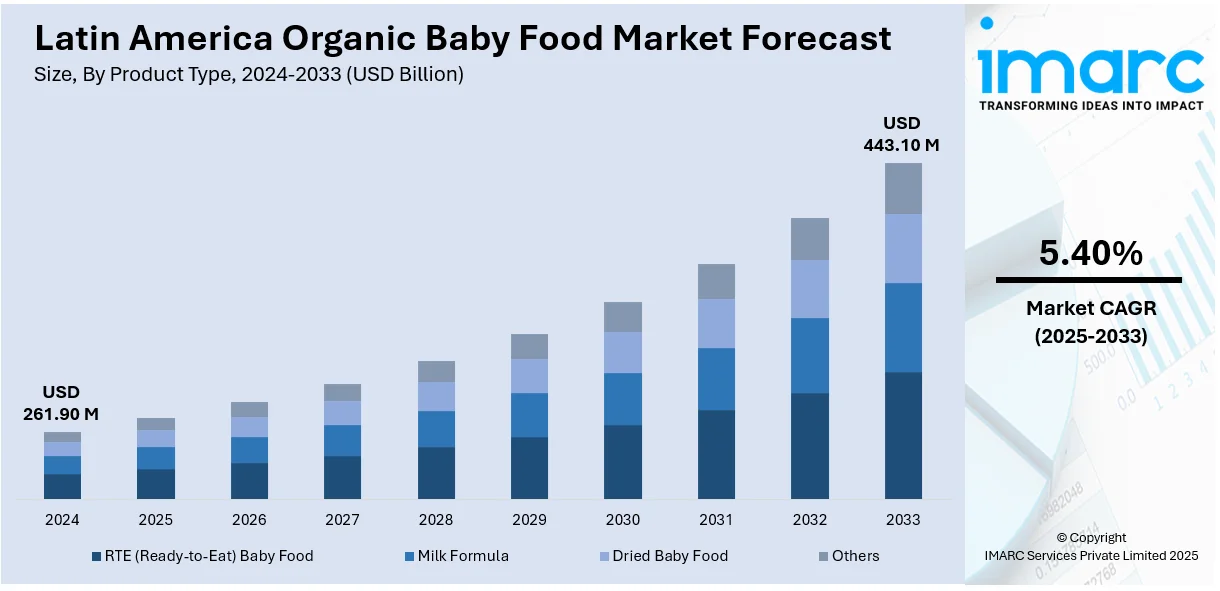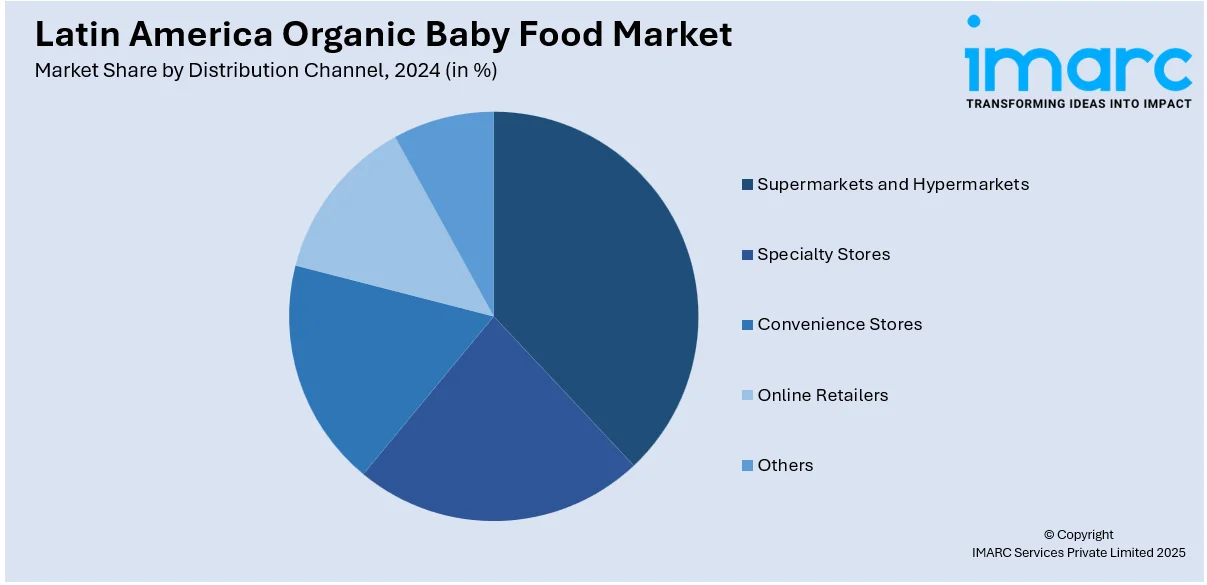
Latin America Organic Baby Food Market Size, Share, Trends and Forecast by Product Type, Distribution Channel and Region, 2025-2033
Latin America Organic Baby Food Market Overview:
The Latin America organic baby food market size reached USD 261.90 Million in 2024. Looking forward, IMARC Group expects the market to reach USD 443.10 Million by 2033, exhibiting a growth rate (CAGR) of 5.40% during 2025-2033. The market is fueled by mounting consumer knowledge about health advantages, growing demand for chemical-free goods, increased parental inclination towards organic products, growth in e-commerce platforms, and increased emphasis on sustainable, environmentally friendly production and farming methods.
|
Report Attribute
|
Key Statistics
|
|---|---|
|
Base Year
|
2024 |
|
Forecast Years
|
2025-2033
|
|
Historical Years
|
2019-2024
|
| Market Size in 2024 | USD 261.90 Million |
| Market Forecast in 2033 | USD 443.10 Million |
| Market Growth Rate 2025-2033 | 5.40% |
Latin America Organic Baby Food Market Trends:
Growing Demand for Clean Label and Natural Ingredients:
One of the key trends driving the Latin America organic baby food market is the growing demand for clean-label foods and natural ingredients. According to Beneo GmbH, 3 out of 4 consumers in Lain America indicated that foods with natural ingredients and/or cleaner label are healthier (and safer) for them, and an overwhelming majority (80%) would like to learn more about the ingredients in their products. Parents in the area are highly conscientious about what they put in their infants' mouths, so they're on the lookout for foods free from artificial additives or other chemicals or preservatives. The greater overall public consciousness these days about how potentially risky man-made ingredients may be is no help. Additionally, there is a healthier approach to consuming spreading out from all around the globe. Organic infant food companies in Latin America respond to it by offering transparent labeling that is easy and does refer to the absence of pesticides, GMOs, and others damaging components. Further, there is high demand for locally produced and organic ingredients, which are reportedly fresher and healthier. With more parents calling for transparency in food manufacturing, the clean-label trend will keep driving demand in this market and encourage manufacturers towards higher quality controls and sustainable sourcing to meet consumer demands.

Rising Popularity of E-commerce and Online Retail:
Online shopping is increasingly becoming the vehicle for distribution of organic infant food throughout Latin America. According to International Trade Organization, Brazil has the biggest economy in Latin America with 14.3% e-commerce growth and should pass US$200 billion by 2026. Online shopping convenience, as well as amplified online availability of organic products, is simplifying how parents are finding lots of different options. With the growth of mobile internet consumption in the region, especially in nations, such as Brazil and Mexico, consumers are intensely using online marketplaces and apps for grocery shopping. Organic baby food companies are capitalizing on this trend by increasing their online presence, providing home delivery options, and marketing their products on social media. The option to compare products, read reviews, and avail promotional discounts is also improving the attractiveness of online shopping for baby food. As e-commerce expands in Latin America, the organic baby food market is expected to be boosted by easier access, creating more opportunities for small and niche brands to gain exposure to a larger audience.
Sustainability and Eco-friendly Packaging Initiatives:
The trend that is propelling the Latin America organic baby food market is sustainability because the manufacturers and consumers have amplified interest in the green approach. The parents desire healthier organic baby food and understand how it is made and packaged. There is a growing need for more eco-friendly packaging, which would have much less harmful environmental impact than in the form of bio-degradable, compostable, or recyclable materials. Organic baby food companies in Latin America are adopting new packaging technologies that reduce plastic usage and are sustainable, as per eco-friendly consumer values. In addition to packaging, there has been heightening awareness of sustainable agriculture as organic farming practices are gaining more prominence as the conservation of biodiversity conserves water and decreases carbon footprints. As environmental consciousness develops in the region, those companies that focus more on sustainability in both formulation as well as packaging are likely to lead the market. Therefore, there is more potential for innovation in sustainable production and sustainable packaging of organic baby food in Latin America.
Latin America Organic Baby Food Market Segmentation:
IMARC Group provides an analysis of the key trends in each segment of the market, along with forecasts at the region level for 2025-2033. Our report has categorized the market based on product type and distribution channel.
Product Type Insights:
- RTE (Ready-to-Eat) Baby Food
- Milk Formula
- Dried Baby Food
- Others
The report has provided a detailed breakup and analysis of the market based on the product type. This includes RTE (ready-to-eat) baby food, milk formula, dried baby food, and others.
Distribution Channel Insights:

- Supermarkets and Hypermarkets
- Specialty Stores
- Convenience Stores
- Online Retailers
- Others
A detailed breakup and analysis of the market based on the distribution channel have also been provided in the report. This includes supermarkets and hypermarkets, specialty stores, convenience stores, online retailers, and others.
Regional Insights:
- Brazil
- Mexico
- Argentina
- Colombia
- Chile
- Peru
- Others
The report has also provided a comprehensive analysis of all the major regional markets, which include Brazil, Mexico, Argentina, Colombia, Chile, Peru, Others.
Competitive Landscape:
The market research report has also provided a comprehensive analysis of the competitive landscape. Competitive analysis such as market structure, key player positioning, top winning strategies, competitive dashboard, and company evaluation quadrant has been covered in the report. Also, detailed profiles of all major companies have been provided.
Latin America Organic Baby Food Market News:
- In February 2024, Nestlé launched a new organic baby food range in Brazil, focusing on locally sourced ingredients and sustainable farming. The lineup includes organic purees and cereals, aligning with Nestlé’s sustainability goals and addressing the growing demand for organic baby nutrition in Latin America.
Latin America Organic Baby Food Market Report Coverage:
| Report Features | Details |
|---|---|
| Base Year of the Analysis | 2024 |
| Historical Period | 2019-2024 |
| Forecast Period | 2025-2033 |
| Units | Million USD |
| Scope of the Report |
Exploration of Historical Trends and Market Outlook, Industry Catalysts and Challenges, Segment-Wise Historical and Future Market Assessment:
|
| Product Types Covered | RTE (Ready-to-Eat) Baby Food, Milk Formula, Dried Baby Food, Others |
| Distribution Channels Covered | Supermarkets and Hypermarkets, Specialty Stores, Convenience Stores, Online Retailers, Others |
| Regions Covered | Brazil, Mexico, Argentina, Colombia, Chile, Peru, Others |
| Customization Scope | 10% Free Customization |
| Post-Sale Analyst Support | 10-12 Weeks |
| Delivery Format | PDF and Excel through Email (We can also provide the editable version of the report in PPT/Word format on special request) |
Key Questions Answered in This Report:
- How has the Latin America organic baby food market performed so far and how will it perform in the coming years?
- What is the breakup of the Latin America organic baby food market on the basis of product type?
- What is the breakup of the Latin America organic baby food market on the basis of distribution channel?
- What is the breakup of the Latin America organic baby food market on the basis of region?
- What are the various stages in the value chain of the Latin America organic baby food market?
- What are the key driving factors and challenges in the Latin America organic baby food?
- What is the structure of the Latin America organic baby food market and who are the key players?
- What is the degree of competition in the Latin America organic baby food market?
Key Benefits for Stakeholders:
- IMARC’s industry report offers a comprehensive quantitative analysis of various market segments, historical and current market trends, market forecasts, and dynamics of the Latin America organic baby food market from 2019-2033.
- The research report provides the latest information on the market drivers, challenges, and opportunities in the Latin America organic baby food market.
- Porter's five forces analysis assist stakeholders in assessing the impact of new entrants, competitive rivalry, supplier power, buyer power, and the threat of substitution. It helps stakeholders to analyze the level of competition within the Latin America organic baby food industry and its attractiveness.
- Competitive landscape allows stakeholders to understand their competitive environment and provides an insight into the current positions of key players in the market.
Need more help?
- Speak to our experienced analysts for insights on the current market scenarios.
- Include additional segments and countries to customize the report as per your requirement.
- Gain an unparalleled competitive advantage in your domain by understanding how to utilize the report and positively impacting your operations and revenue.
- For further assistance, please connect with our analysts.
 Inquire Before Buying
Inquire Before Buying
 Speak to an Analyst
Speak to an Analyst
 Request Brochure
Request Brochure
 Request Customization
Request Customization




.webp)




.webp)












